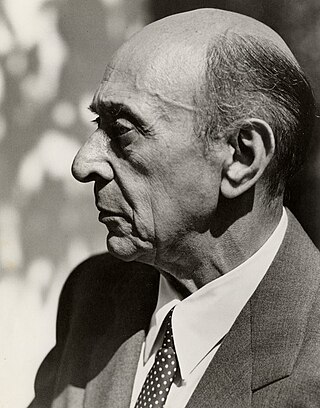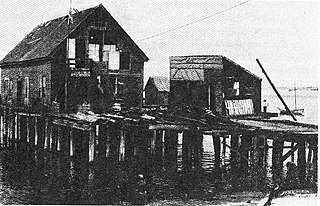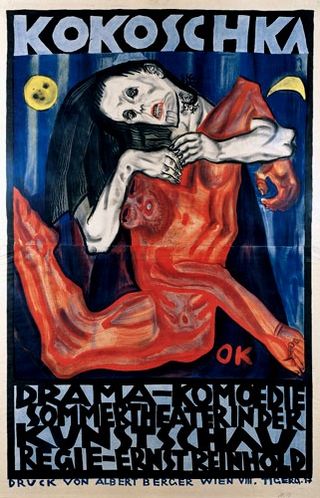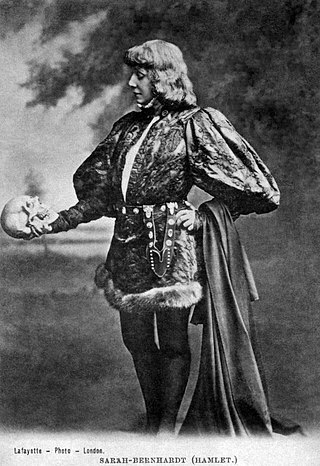
The following outline is provided as an overview of and topical guide to theatre:

Max Reinhardt was an Austrian-born theatre and film director, intendant, and theatrical producer. With his radically innovative and avante garde stage productions, Reinhardt is regarded as one of the most prominent stage directors of the early 20th century.

The theatre of the absurd is a post–World War II designation for particular plays of absurdist fiction written by a number of primarily European playwrights in the late 1950s. It is also a term for the style of theatre the plays represent. The plays focus largely on ideas of existentialism and express what happens when human existence lacks meaning or purpose and communication breaks down. The structure of the plays is typically a round shape, with the finishing point the same as the starting point. Logical construction and argument give way to irrational and illogical speech and to the ultimate conclusion—silence.

Expressionism is a modernist movement, initially in poetry and painting, originating in Northern Europe around the beginning of the 20th century. Its typical trait is to present the world solely from a subjective perspective, distorting it radically for emotional effect in order to evoke moods or ideas. Expressionist artists have sought to express the meaning of emotional experience rather than physical reality.

A Dream Play, sometimes staged in English as The Dream Play, is a fantasy play in 14 scenes written in 1901 by the Swedish playwright August Strindberg. It was published in Swedish in 1902 and first performed in Stockholm on 17 April 1907. It remains one of Strindberg's most admired and influential dramas, seen as an important precursor to both dramatic Expressionism and Surrealism.

Theater in the United States is part of the old European theatrical tradition and has been heavily influenced by the British theater. The central hub of the American theater scene is Manhattan, with its divisions of Broadway, Off-Broadway, and Off-Off-Broadway. Many movie and television stars have gotten their big break working in New York productions. Outside New York, many cities have professional regional or resident theater companies that produce their own seasons, with some works being produced regionally with hopes of eventually moving to New York. U.S. theater also has an active community theater culture, which relies mainly on local volunteers who may not be actively pursuing a theatrical career.

Sophie Anita Treadwell was an American playwright and journalist of the first half of the 20th century. She is best known for her play Machinal which is often included in drama anthologies as an example of an expressionist or modernist play. Treadwell wrote dozens of plays, several novels, as well as serial stories and countless articles that appeared in newspapers. In addition to writing plays for the theatre, Treadwell also produced, directed and acted in some of her productions. The styles and subjects of Treadwell's writings are vast, but many present women's issues of her time, subjects of current media coverage, or aspects of Treadwell's Mexican heritage.

Machinal is a 1928 play by American playwright and journalist Sophie Treadwell, inspired by the real-life case of convicted and executed murderer Ruth Snyder. Its Broadway premiere, directed by Arthur Hopkins, is considered one of the highpoints of Expressionist theatre on the American stage.

The term expressionism "was probably first applied to music in 1918, especially to Schoenberg", because like the painter Wassily Kandinsky (1866–1944) he avoided "traditional forms of beauty" to convey powerful feelings in his music. Theodor Adorno interprets the expressionist movement in music as seeking to "eliminate all of traditional music's conventional elements, everything formulaically rigid". This he sees as analogous "to the literary ideal of the 'scream' ". As well Adorno sees expressionist music as seeking "the truthfulness of subjective feeling without illusions, disguises or euphemisms". Adorno also describes it as concerned with the unconscious, and states that "the depiction of fear lies at the centre" of expressionist music, with dissonance predominating, so that the "harmonious, affirmative element of art is banished". Expressionist music would "thus reject the depictive, sensual qualities that had come to be associated with impressionist music. It would endeavor instead to realize its own purely musical nature—in part by disregarding compositional conventions that placed 'outer' restrictions on the expression of 'inner' visions".
The Son is a five-act Expressionist play by the German playwright Walter Hasenclever. It was the first self-proclaimed, full-length Expressionist play to be produced, though its dramatic structure is more or less realistic. It takes as its subject the conflict between the generations and a rejection of the world in general by the young. It is a semi-autobiographical work.

The Provincetown Players was a collective of artists, people and writers, intellectuals, and amateur theater enthusiasts. Under the leadership of the husband and wife team of George Cram “Jig” Cook and Susan Glaspell from Iowa, the Players produced two seasons in Provincetown, Massachusetts and six seasons in New York City, between 1916 and 1922. The company's founding has been called "the most important innovative moment in American theatre." Its productions helped launch the careers of Eugene O'Neill and Susan Glaspell, and ushered American theatre into the Modern era.

Nineteenth-century theatre describes a wide range of movements in the theatrical culture of Europe and the United States in the 19th century. In the West, they include Romanticism, melodrama, the well-made plays of Scribe and Sardou, the farces of Feydeau, the problem plays of Naturalism and Realism, Wagner's operatic Gesamtkunstwerk, Gilbert and Sullivan's plays and operas, Wilde's drawing-room comedies, Symbolism, and proto-Expressionism in the late works of August Strindberg and Henrik Ibsen.

Friedrich Carl Georg Kaiser, called Georg Kaiser, was a German dramatist.

Drums in the Night is a play by the German playwright Bertolt Brecht. Brecht wrote it between 1919 and 1920, and it received its first theatrical production in 1922. It is in the Expressionist style of Ernst Toller and Georg Kaiser. The play—along with Baal and In the Jungle—won the Kleist Prize for 1922 ; the play was performed all over Germany as a result. Brecht later claimed that he had only written it as a source of income.
Twentieth-century theatre describes a period of great change within the theatrical culture of the 20th century, mainly in Europe and North America. There was a widespread challenge to long-established rules surrounding theatrical representation; resulting in the development of many new forms of theatre, including modernism, expressionism, impressionism, political theatre and other forms of Experimental theatre, as well as the continuing development of already established theatrical forms like naturalism and realism.
Arnolt Bronnen was an Austrian playwright and director.

Murderer, the Hope of Women is a short Expressionist play written by the painter Oskar Kokoschka. It focuses more on the actions and appearances of its characters than on their dialogue. Its performance was received with much criticism, as it was a break from classical drama and part of the modernist avant-garde movement in German culture.

Drama is the specific mode of fiction represented in performance: a play, opera, mime, ballet, etc., performed in a theatre, or on radio or television. Considered as a genre of poetry in general, the dramatic mode has been contrasted with the epic and the lyrical modes ever since Aristotle's Poetics —the earliest work of dramatic theory.

Theatre or theater is a collaborative form of performing art that uses live performers, usually actors or actresses, to present the experience of a real or imagined event before a live audience in a specific place, often a stage. The performers may communicate this experience to the audience through combinations of gesture, speech, song, music, and dance. It is the oldest form of drama, though live theatre has now been joined by modern recorded forms. Elements of art, such as painted scenery and stagecraft such as lighting are used to enhance the physicality, presence and immediacy of the experience. Places, normally buildings, where performances regularly take place are also called "theatres", as derived from the Ancient Greek θέατρον, itself from θεάομαι.

A play is a form of drama that primarily consists of dialogue between characters and is intended for theatrical performance rather than mere reading. The creator of a play is known as a playwright.

















